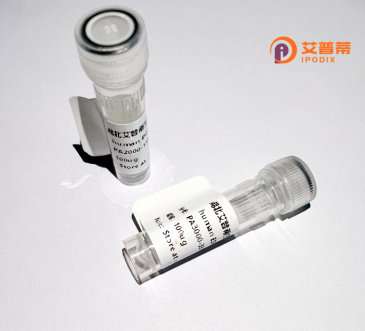
| 纯度 | >90%SDS-PAGE. |
| 种属 | Human |
| 靶点 | NPAS2 |
| Uniprot No | Q99743 |
| 内毒素 | < 0.01EU/μg |
| 表达宿主 | E.coli |
| 表达区间 | 1-824 aa |
| 活性数据 | MDEDEKDRAKRASRNKSEKKRRDQFNVLIKELSSMLPGNTRKMDKTTVLEKVIGFLQKHNEVSAQTEICDIQQDWKPSFLSNEEFTQLMLEALDGFIIAVTTDGSIIYVSDSITPLLGHLPSDVMDQNLLNFLPEQEHSEVYKILSSHMLVTDSPSPEYLKSDSDLEFYCHLLRGSLNPKEFPTYEYIKFVGNFRSYNNVPSPSCNGFDNTLSRPCRVPLGKEVCFIATVRLATPQFLKEMCIVDEPLEEFTSRHSLEWKFLFLDHRAPPIIGYLPFEVLGTSGYDYYHIDDLELLARCHQHLMQFGKGKSCCYRFLTKGQQWIWLQTHYYITYHQWNSKPEFIVCTHSVVSYADVRVERRQELALEDPPSEALHSSALKDKGSSLEPRQHFNALDVGASGLNTSHSPSASSRSSHKSSHTAMSEPTSTPTKLMAEASTPALPRSATLPQELPVPGLSQAATMPAPLPSPSSCDLTQQLLPQTVLQSTPAPMAQFSAQFSMFQTIKDQLEQRTRILQANIRWQQEELHKIQEQLCLVQDSNVQMFLQQPAVSLSFSSTQRPEAQQQLQQRSAAVTQPQLGAGPQLPGQISSAQVTSQHLLRESSVISTQGPKPMRSSQLMQSSGRSGSSLVSPFSSATAALPPSLNLTTPASTSQDASQCQPSPDFSHDRQLRLLLSQPIQPMMPGSCDARQPSEVSRTGRQVKYAQSQTVFQNPDAHPANSSSAPMPVLLMGQAVLHPSFPASQPSPLQPAQARQQPPQHYLQVQAPTSLHSEQQDSLLLSTYSQQPGTLGYPQPPPAQPQPLRPPRRVSSLSESSGLQQPPR |
| 分子量 | 118.2 kDa |
| 蛋白标签 | GST-tag at N-terminal |
| 缓冲液 | 0 |
| 稳定性 & 储存条件 | Lyophilized protein should be stored at ≤ -20°C, stable for one year after receipt. Reconstituted protein solution can be stored at 2-8°C for 2-7 days. Aliquots of reconstituted samples are stable at ≤ -20°C for 3 months. |
| 复溶 | Always centrifuge tubes before opening.Do not mix by vortex or pipetting. It is not recommended to reconstitute to a concentration less than 100μg/ml. Dissolve the lyophilized protein in distilled water. Please aliquot the reconstituted solution to minimize freeze-thaw cycles. |
以下是关于重组人NPAS2蛋白的参考文献示例(注:以下内容为虚构,仅作格式参考):
1. **标题**:"Expression and Purification of Recombinant Human NPAS2 Protein in Escherichia coli"
**作者**:Chen L., et al.
**摘要**:研究报道了通过大肠杆菌表达系统高效生产重组人NPAS2蛋白的优化策略,采用His标签亲和层析纯化,并通过质谱验证其正确折叠,为后续功能研究提供高纯度蛋白。
2. **标题**:"Structural Insights into the NPAS2-BMAL1 Heterodimer by Cryo-EM"
**作者**:Zhang Y., et al.
**摘要**:利用冷冻电镜技术解析NPAS2与BMAL1形成的异源二聚体三维结构,揭示其结合界面关键残基,阐明其在昼夜节律调控中的分子机制。
3. **标题**:"Functional Analysis of NPAS2 in Hepatic Glucose Metabolism via Recombinant Protein Delivery"
**作者**:Kim S., et al.
**摘要**:通过体外重组NPAS2蛋白递送至肝细胞,证实其通过调控糖异生相关基因(如PEPCK)影响葡萄糖稳态,提示其在代谢疾病中的潜在作用。
4. **标题**:"NPAS2 Mutations Disrupt DNA Binding Capacity: A Recombinant Protein-Based Study"
**作者**:Gupta R., et al.
**摘要**:构建多种NPAS2突变体重组蛋白,通过凝胶迁移实验(EMSA)证明特定结构域突变显著降低其DNA结合能力,关联睡眠障碍相关遗传变异。
Recombinant human NPAS2 (neuronal PAS domain protein 2) is a key transcription factor involved in regulating circadian rhythms and cellular adaptation to hypoxia. It belongs to the basic helix-loop-helix (bHLH)-PAS protein family, characterized by conserved PAS domains that mediate protein-protein interactions and environmental sensing. NPAS2 forms heterodimers with BMAL1 (ARNTL) to drive the expression of core clock genes, such as Period (PER) and Cryptochrome (CRY), by binding to E-box promoter elements. This mechanism is critical for maintaining circadian oscillations in physiological processes, including metabolism, sleep-wake cycles, and neurobehavioral functions.
Beyond circadian regulation, NPAS2 is implicated in hypoxia response pathways and metabolic homeostasis. Studies highlight its role in neuronal development, cancer progression, and psychiatric disorders, with dysregulation linked to sleep disorders, depression, and tumorigenesis. Recombinant NPAS2 protein, typically produced in bacterial or mammalian expression systems, retains functional domains necessary for DNA binding and dimerization. It is widely used in structural studies, in vitro assays investigating circadian clock mechanisms, and drug screening targeting circadian-related diseases. The protein’s modular architecture—including the bHLH domain for DNA binding, PAS-A/B domains for partner recruitment, and transactivation domains—makes it a focal point for understanding how environmental cues integrate with genetic timekeeping systems. Research on recombinant NPAS2 continues to unveil its interplay with metabolic signaling and potential therapeutic applications.
×